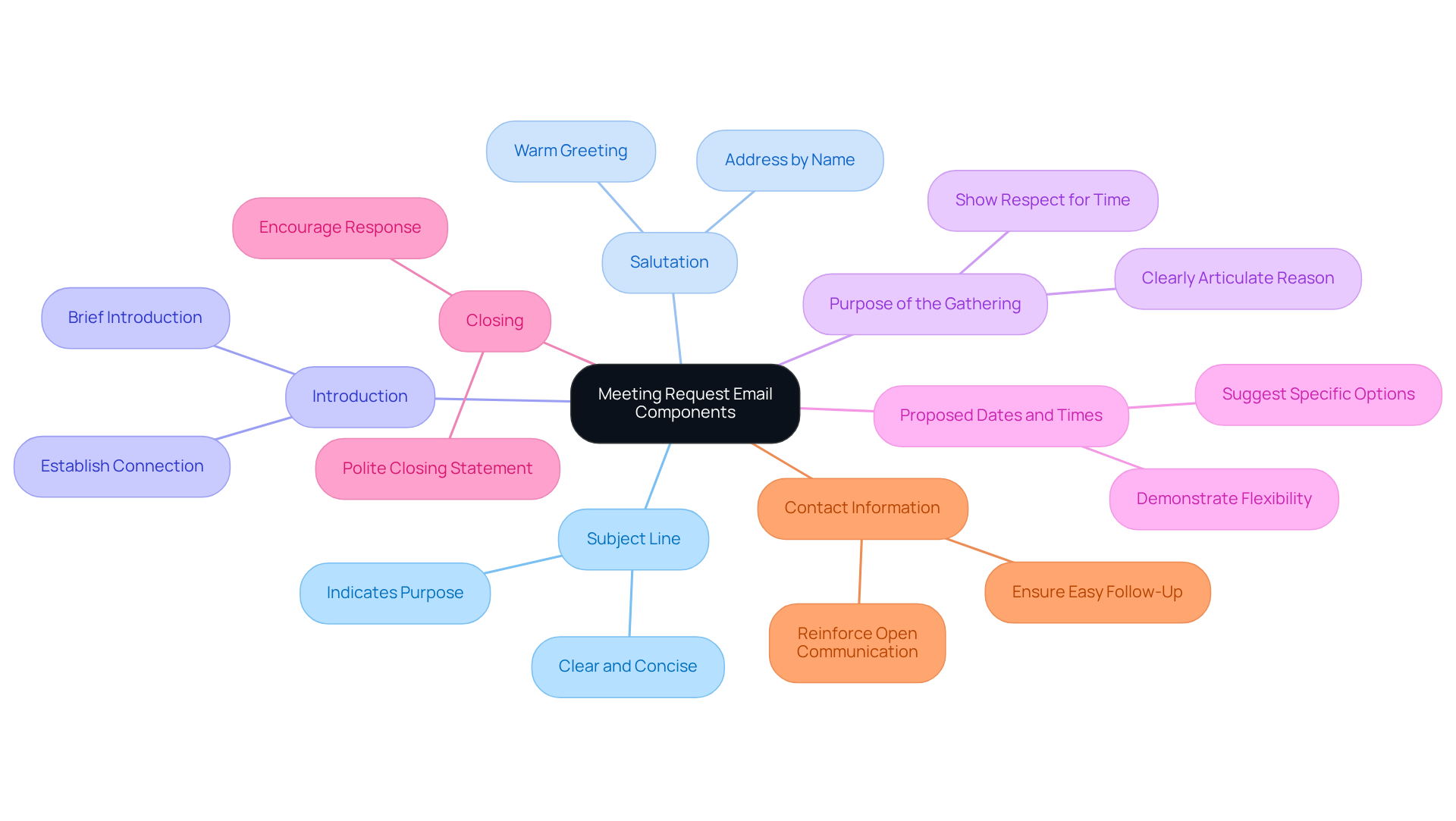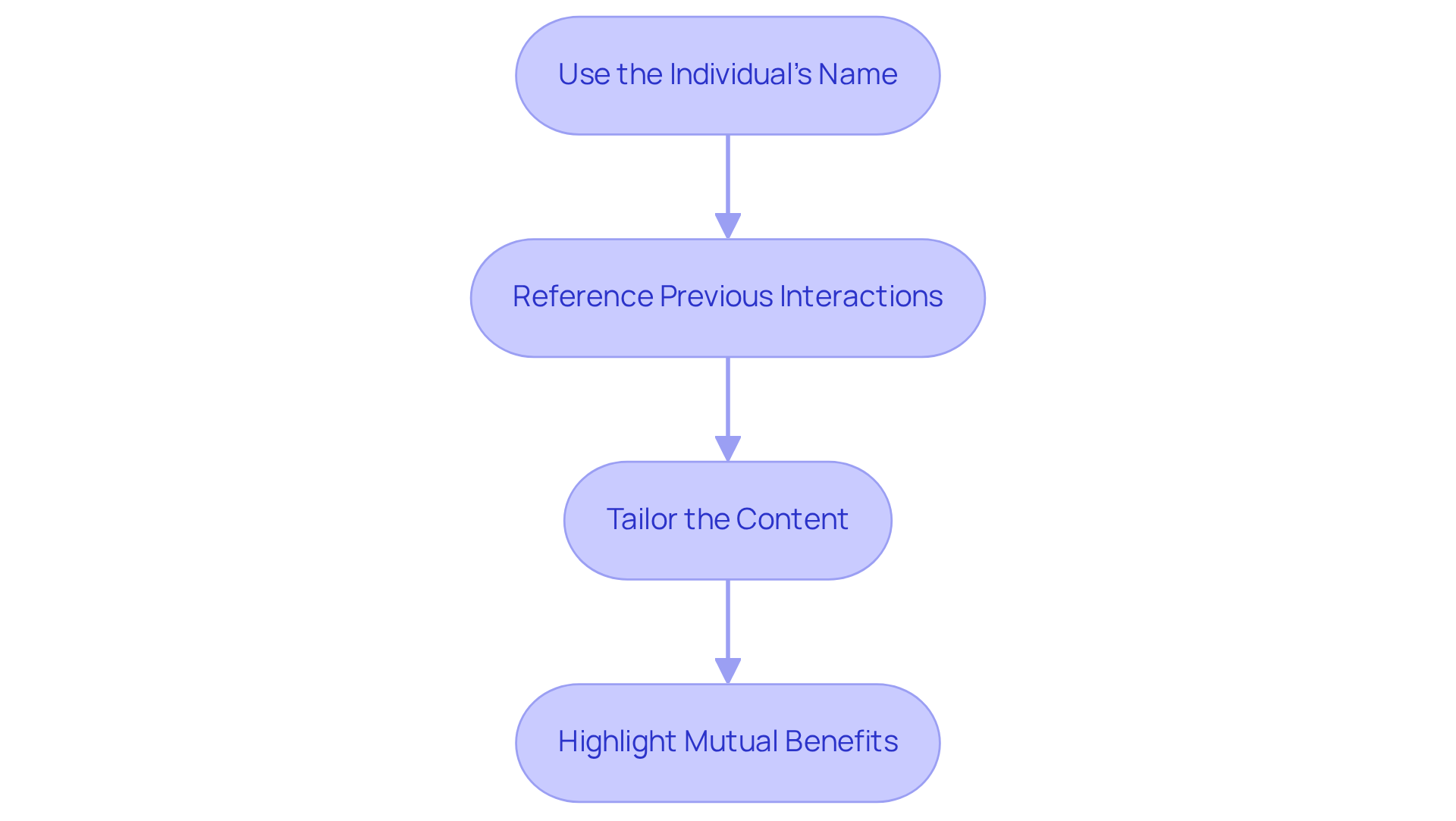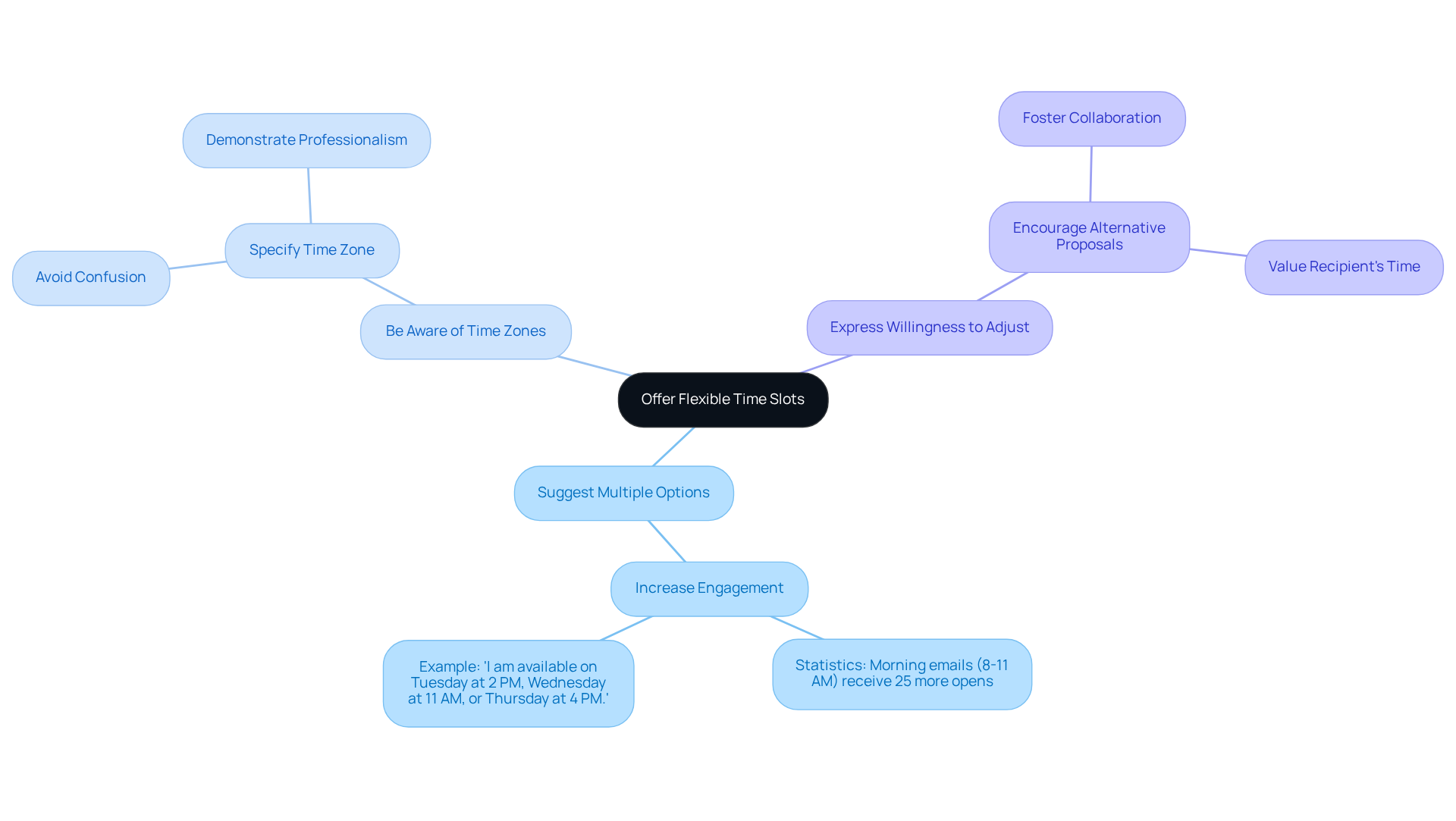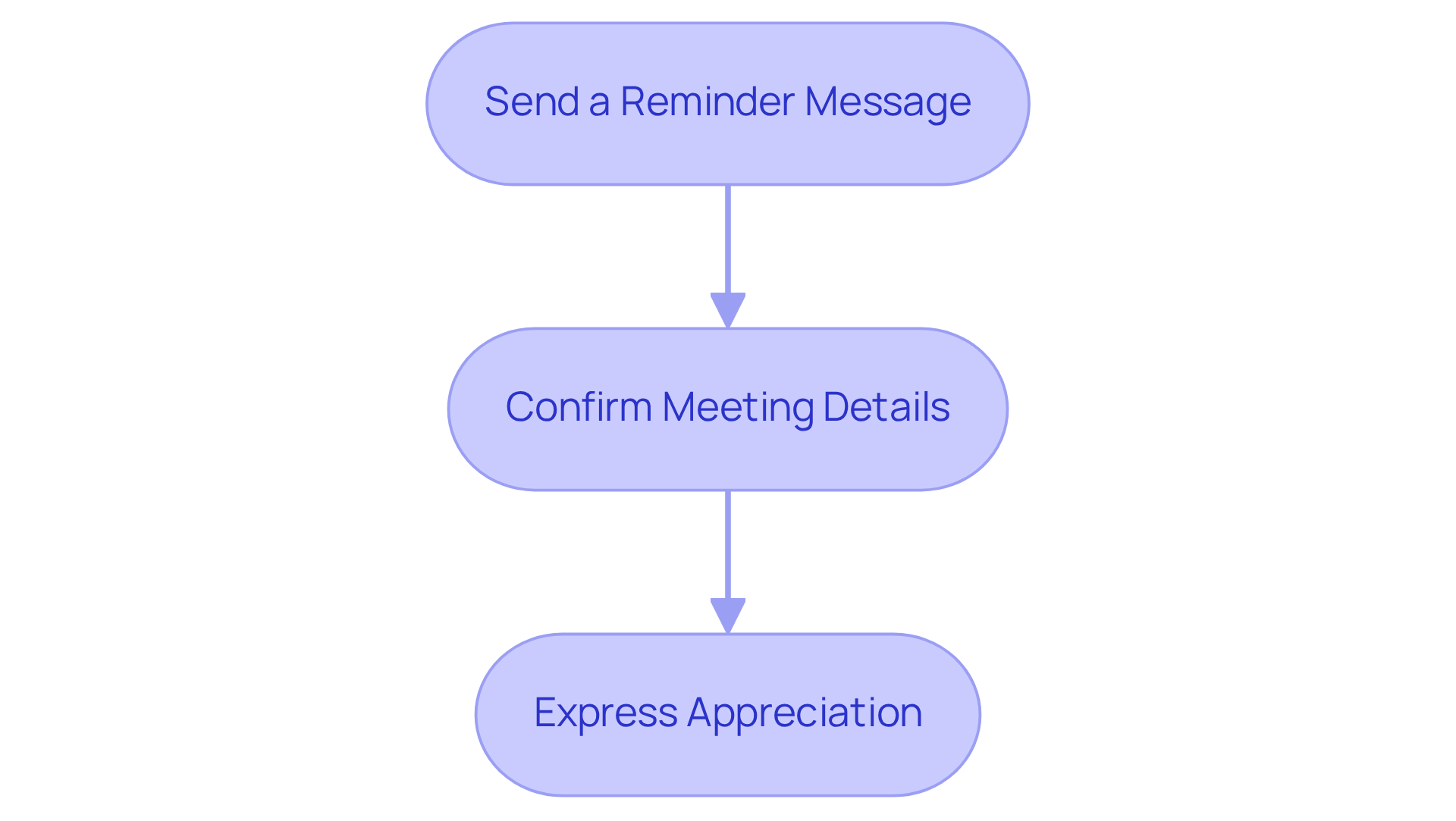Overview
This article highlights four essential practices for crafting an effective email to schedule a meeting, emphasizing the importance of:
- Clear communication
- Personalization
- Flexibility
- Follow-up
By suggesting multiple time slots, addressing the recipient by name, and confirming meeting details, you can significantly enhance the chances of receiving a positive response. These strategies not only improve communication but also help in fostering stronger professional relationships. We understand that reaching out can feel daunting, but with these supportive practices, you can approach scheduling with confidence and care.
Introduction
Crafting an effective email to schedule a meeting can truly transform your professional interactions and outcomes. By understanding the essential components of a meeting request, you can enhance your communication and foster stronger relationships.
But what key practices can turn a simple email into an engaging invitation that not only captures attention but also encourages a positive response? In this article, we will explore four crucial strategies that streamline the scheduling process while highlighting the importance of personalization and flexibility in meeting arrangements.
Together, we can navigate these challenges and achieve success in your professional endeavors.
Identify Key Components of a Meeting Request Email
Crafting a well-thought-out sample email for scheduling a meeting is essential for effective communication. Here are some key components to consider:
- Subject Line: Start with a clear and concise subject line that indicates the purpose of your email, such as "Meeting Request: [Topic]." This helps the recipient immediately understand your intent.
- Salutation: A warm and courteous greeting addressing the individual by name sets a positive tone for your message.
- Introduction: If the recipient is not familiar with you, a brief introduction can help establish a connection and build trust.
- Purpose of the Gathering: Clearly articulate the reason for the meeting and what you hope to achieve. This transparency shows respect for the recipient’s time and fosters a collaborative spirit.
- Proposed Dates and Times: Suggest specific dates and times for the gathering, making it easier for the recipient to schedule. Offering options demonstrates flexibility and consideration.
- Closing: End with a polite closing statement that encourages a response, such as "Looking forward to your reply." This invites engagement and shows your eagerness to connect.
- Contact Information: Including your contact details ensures easy follow-up, reinforcing your commitment to open communication.
By incorporating these elements, your sample email for scheduling a meeting not only conveys your message effectively but also shows that you care about the recipient’s experience and needs.

Personalize Your Message for Greater Impact
To personalize your meeting request email:
- Use the individual's name: Address the person by their first name to create a friendly tone that feels warm and inviting.
- Reference previous interactions: Mention any prior conversations or shared experiences to establish rapport and show you value your connection.
- Tailor the content: Customize the email to reflect the individual's interests or needs, demonstrating your understanding of their perspective and fostering a sense of care.
- In your sample email for scheduling a meeting, highlight mutual benefits by clearly expressing how the gathering will benefit both sides, making it more appealing for the invitee to accept the invitation and reinforcing a collaborative spirit.

Offer Flexible Time Slots to Accommodate Recipients
When drafting a sample email for scheduling a meeting, it's important to emphasize adaptability to accommodate your audience's availability. Here are some key practices to consider:
-
Suggest Multiple Options: Offering at least two or three specific time slots allows the recipient to choose what works best for them. For example, you might say, "I am available on Tuesday at 2 PM, Wednesday at 11 AM, or Thursday at 4 PM." This approach not only respects their schedule but also increases the likelihood of a positive response. Did you know that statistics show offering multiple options can significantly boost engagement? Morning emails (8-11 AM) receive 25% more opens than those sent in the afternoon.
-
Be Aware of Time Zones: If the person you are addressing is in a different time zone, make sure to clearly specify the zone for your suggested times. This consideration helps avoid confusion and demonstrates your professionalism.
-
Express Willingness to Adjust: Encourage the recipient to propose alternative time slots if your options don’t align with their schedule. This openness fosters collaboration and shows that you value their time, making it easier to use a sample email for scheduling a meeting at a mutually convenient time for discussion. As Elisa DeMartino wisely states, "Every effective request requires a clear and unambiguous call to action."
By applying these strategies, you can enhance the effectiveness of your requests and build stronger connections with potential clients. Together, we can achieve success in fostering meaningful relationships.

Follow Up to Confirm Meeting Arrangements
To effectively follow up on your meeting request, consider these gentle reminders:
-
If you haven’t received a response within a few days, kindly send a reminder message, which can be a sample email for scheduling a meeting, reiterating your request. This small gesture shows your commitment and understanding of their busy schedule.
-
Confirm Details: Once the meeting is accepted, take a moment to send a confirmation email. When crafting a sample email for scheduling a meeting, be sure to include the date, time, location (or virtual link), and agenda. This not only clarifies expectations but also reinforces your professionalism and respect for their time.
-
Express Appreciation: Always remember to thank the recipient for their time and willingness to meet. This simple act of gratitude helps to strengthen your relationship and fosters a positive connection.
By following these steps, you not only ensure effective communication but also demonstrate your care and consideration for those you wish to connect with.

Conclusion
Crafting an effective sample email for scheduling a meeting is more than just sending a message; it’s about nurturing connections through clarity, personalization, and flexibility. By focusing on key components like a clear subject line, a warm salutation, and a well-articulated purpose, you significantly increase the chances of receiving a positive response.
Let’s recap some essential practices:
- Personalizing your message helps foster genuine connections.
- Offering multiple time slots accommodates the recipient’s schedule.
- Following up with reminders and confirmations shows respect for their time.
These steps not only enhance communication but also reflect a deep understanding of the recipient's priorities, paving the way for more productive interactions.
In today’s world, where effective communication is vital, mastering the art of scheduling meetings through thoughtful emails can lay the groundwork for successful professional relationships. By emphasizing the importance of these practices, we can cultivate more fruitful discussions and collaborations. Remember, a well-crafted email is not just a message; it’s a powerful tool in your professional arsenal that can open doors to new opportunities.
Frequently Asked Questions
What is the purpose of a meeting request email?
The purpose of a meeting request email is to effectively communicate the intent to schedule a meeting, providing clarity and respect for the recipient's time.
How should I start the subject line of a meeting request email?
Start with a clear and concise subject line that indicates the purpose of your email, such as "Meeting Request: [Topic]."
Why is a salutation important in a meeting request email?
A warm and courteous greeting that addresses the individual by name sets a positive tone for your message.
What should I include in the introduction of a meeting request email?
If the recipient is not familiar with you, a brief introduction can help establish a connection and build trust.
How do I clearly articulate the purpose of the meeting in the email?
Clearly articulate the reason for the meeting and what you hope to achieve, showing transparency and respect for the recipient’s time.
What is the best way to propose dates and times for the meeting?
Suggest specific dates and times for the gathering, making it easier for the recipient to schedule while demonstrating flexibility and consideration.
How should I close a meeting request email?
End with a polite closing statement that encourages a response, such as "Looking forward to your reply," inviting engagement and showing eagerness to connect.
Why is it important to include contact information in the email?
Including your contact details ensures easy follow-up and reinforces your commitment to open communication.




